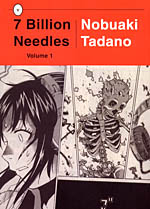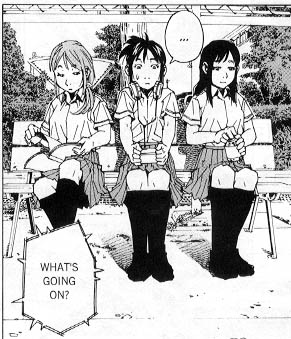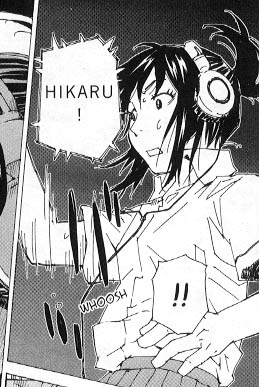 By Nobuaki Tadano
By Nobuaki Tadano
192 pages, black and white
Published by Vertical
You might think about buying 7 Billion Needles based entirely off the cover. That’s because Vertical has designed it like an old science-fiction paperback, complete with orange band up at the top, and a large font text description on the back. If this is the sort of thing to make you think, "I need to read this book" then you are fortunately also in luck, because Nobuaki Tadano’s 7 Billion Needles is inspired by the 1950 science-fiction novel Needle by Hal Clement, and this is a book where the cover tells you exactly what you’re in for.
Like the classic novel Needle, Tadano’s story involves two alien beings that have come to Earth; one a killer (Maelstrom), the other a hunter (Horizon), both merging with a human in order to survive on this planet. Unfortunately for Horizon, it has chosen to merge with Hikaru Takabe, an introverted loner who hides behind her ever-present headphones and drifts through life after the recent death of her parents. From there, the story ‘s basic strokes are familiar; Horizon having to convince Hikaru that both Horizon and Maelstrom are not only real but a genuine danger, and that as a merged being they need to find and stop Maelstrom before it kills all life on the planet.
 It’s not so much the basic ideas in 7 Billion Needles where the book stands out, but rather the smaller details. Tadano slowly parcels out information about Hikaru and why she chooses to seal herself off from the rest of the world; at first it looks to be due to the death of her parents (something her aunt and uncle worry about), but as the book progresses we start to get hints that there’s more to Hikaru than initially meets the eye. In general Hikaru is an entertaining character to read about; she resists believing up until the point where it’s impossible to shut out, but even then her reactions to Horizon’s requests are entertaining and telling. Tadano writes Hikaru in such a way that her introvert nature is believable and understandable to the reader, even as Horizon seems baffled by the sequence of events. And when Hikaru does finally end up with "friends" it’s not a sudden shift in Hikaru herself, but rather the people around her. It’s a scene that is written well in no small part due to Hikaru’s general bewilderment over the entire sequence of events.
It’s not so much the basic ideas in 7 Billion Needles where the book stands out, but rather the smaller details. Tadano slowly parcels out information about Hikaru and why she chooses to seal herself off from the rest of the world; at first it looks to be due to the death of her parents (something her aunt and uncle worry about), but as the book progresses we start to get hints that there’s more to Hikaru than initially meets the eye. In general Hikaru is an entertaining character to read about; she resists believing up until the point where it’s impossible to shut out, but even then her reactions to Horizon’s requests are entertaining and telling. Tadano writes Hikaru in such a way that her introvert nature is believable and understandable to the reader, even as Horizon seems baffled by the sequence of events. And when Hikaru does finally end up with "friends" it’s not a sudden shift in Hikaru herself, but rather the people around her. It’s a scene that is written well in no small part due to Hikaru’s general bewilderment over the entire sequence of events.
 The art in 7 Billion Needles is nice, with a sharp, crackly look to the characters. Characters have shirts with large, geometric creases along their backs, and sharp angles along ears and noses where other artists might have drawn something smooth and rounded. It makes Tadano’s art stand out from the generic look that a lot of manga has, and it’s part of what drew me into the book in a matter of pages. I also like how Tadano handles movement and body language. When Hikaru suddenly has her new "friends" sit down on either side of her, the way she pulls into her shell emotionally is echoed in her posture, pulling her shoulders up and her hands into her lap, with legs tightly clenched together. You can almost feel her discomfort just by looking at her. The few fight scenes also work out well, building in power as they grow into something increasingly energetic and discomforting. Tadano is also smart in showing just what the reader needs to see and nothing else; when Maelstrom and Horizon first face off in the supply closet, Maelstrom’s attack is nasty in part because of how Tadano pulls back the view to show more and more of Hikaru even as that deadly strike first occurs.
The art in 7 Billion Needles is nice, with a sharp, crackly look to the characters. Characters have shirts with large, geometric creases along their backs, and sharp angles along ears and noses where other artists might have drawn something smooth and rounded. It makes Tadano’s art stand out from the generic look that a lot of manga has, and it’s part of what drew me into the book in a matter of pages. I also like how Tadano handles movement and body language. When Hikaru suddenly has her new "friends" sit down on either side of her, the way she pulls into her shell emotionally is echoed in her posture, pulling her shoulders up and her hands into her lap, with legs tightly clenched together. You can almost feel her discomfort just by looking at her. The few fight scenes also work out well, building in power as they grow into something increasingly energetic and discomforting. Tadano is also smart in showing just what the reader needs to see and nothing else; when Maelstrom and Horizon first face off in the supply closet, Maelstrom’s attack is nasty in part because of how Tadano pulls back the view to show more and more of Hikaru even as that deadly strike first occurs.
Reading 7 Billion Needles Vol. 1 reminded me in some ways of Parasyte, only in this case it’s less cartoonish and much creepier. And, with just a four-volume length, 7 Billion Needles already feels much more tight and focused. I came for the beautiful production design of 7 Billion Needles, but I’ll stay for the excellent story and art.
Purchase Links: Amazon.com | Powell’s Books
